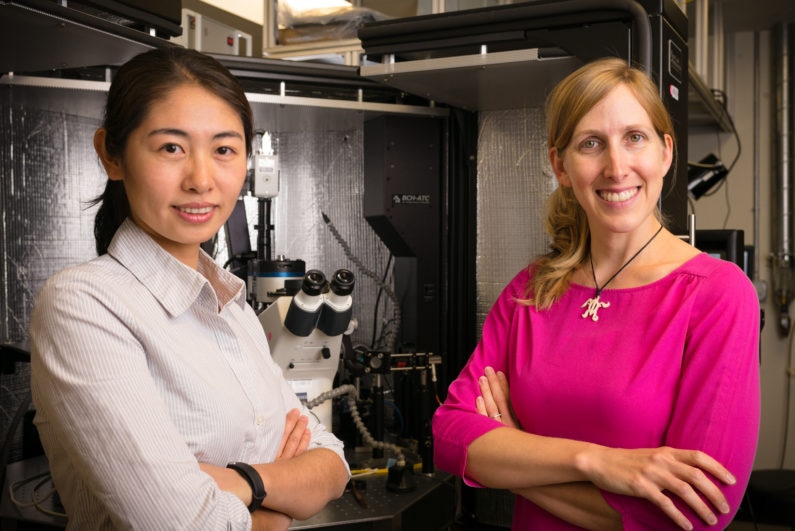Sep 26 2017
Molecules developed in labs frequently have a disadvantage that is mysteriously avoided by nature. The problem refers to the fact that a number of molecules are chiral, meaning they have an asymmetrical structure.
A consequence of chirality is that when a chiral molecule is synthesized we also frequently make its doppelganger, a mirror image of the intended molecule. The two may look similar but, like the left and right hand, they cannot be interchanged.
 Jennifer Dionne, associate professor of materials science and engineering at Stanford University (right), and Yang Zhao, a postdoctoral fellow, in the Dionne Lab. Dionne and Zhao are developing a new technique that uses light to separate mirrored molecules. (Image credit: Aaron Kehoe)
Jennifer Dionne, associate professor of materials science and engineering at Stanford University (right), and Yang Zhao, a postdoctoral fellow, in the Dionne Lab. Dionne and Zhao are developing a new technique that uses light to separate mirrored molecules. (Image credit: Aaron Kehoe)
Depending on the handedness, the molecule limonene smells like turpentine or oranges, ibuprofen is capable of being four times more potent and thalidomide either leads to severe birth defects or treats morning sickness.
Approximately 50 percent of drugs and 30 percent of agrichemicals are chiral, which means they can be left- or right-handed. Of those, more than 90 percent are sold as mixtures of both handed molecules because it’s so hard to separate them.
Jennifer Dionne, Associate Professor of Materials Science and Engineering, Stanford University
The standard chemical methods of separating molecules – to retain the good version and weed out the bad – are inefficient, expensive or time-intensive.
Dionne’s lab has now demonstrated one approach that holds promise for separating chiral molecules. It deals with a nanostructured filter that attracts one handed specimen while repelling its mirror image when illuminated with a laser. The team published this technique in the September 25th edition of Nature Nanotechnology.
A light handshake
Focused light can modify the momentum of an object. This effect has been employed for creating unbelievable tools, known as optical tweezers, which enable Scientists to manipulate particles with extremely focused beams of light. (Steven Chu, Professor of Physics at Stanford and Professor of Molecular and Cellular Physiology in the Stanford School of Medicine, earned the Nobel Prize in Physics in 1997, because of his work with optical tweezers.) Even though the idea of tweezing apart chiral forms has seemed appealing, a number of the molecules to be targeted are too small to be pulled apart by optical forces directly.
Yang Zhao, a Postdoctoral Fellow in the Dionne lab, overcame that weakness by developing a nanostructure that permits circularly polarized light to interact more powerfully with small specimens. The light path in the nanostructure maps a spiral in one direction but not the other. Once the chiral light has passed via this path, it works together with molecules that complement its shape and pulls those downward.
By measuring the forces exerted on chiral specimens, the Researchers tested their prototype. They developed a tool known as a chiral optical force microscope, which includes the optical tweezers with an atomic force microscope (AFM), a tool that has the potential to resolve the chemical structure of a single molecule. A chiral AFM tip served as the chiral specimen and, at the same time, mapped out the forces particular to the handedness of the tip. They proved that the optical forces developed by their tweezers are strong enough in order to separate specific chiral molecules.
Building the optical filter
The team is yet to test the tweezers on actual chiral molecules, but Zhao has started to quantify the forces they can apply to DNA and particular proteins. These chiral molecules have a precise handedness in nature but can be either handedness if produced in a lab.
The next step will be to gather their tweezers into a sort of filter that is capable of separating two forms of a drug or other molecules.
“We will put many of these nanostructures on a microfluidic chip where a drug of interest can be introduced,” said Zhao. “If it works as we want it to, we should be able to have the drug separated upon illumination.”
Besides sorting drugs to make them more effective or safer, the Researchers believe that their tweezers could be put to other uses, such as monitoring the unfolding or folding of a protein or allowing light-mediated synthesis of chiral chemicals.
Stanford Co-authors of this paper include Brian Baum, Justin A. Briggs, Alice Lay, Olivia Alexandra Reyes-Becerra and Amr A.E. Saleh, who is also of Cairo University in Giza, Egypt. Additional Co-author Marie Anne van de Haar is at FOM Institute AMOLF in Amsterdam, Netherlands. Dionne is also a member of Stanford Bio-X, an affiliate of the Precourt Institute for Energy and a member of the Stanford Neurosciences Institute.
This research was funded by The Gordon and Betty Moore Foundation, the National Science Foundation, the Air Force Office of Scientific Research and a European Research Council grant funded this research.